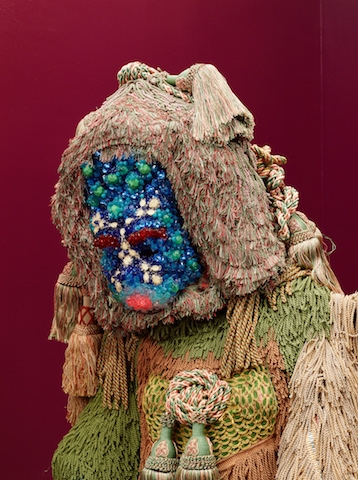Just as Raúl de Nieves’s acetate window treatments, reminiscent of stained glass, transformed the Whitney Museum’s fifth floor into a sacred space for last year’s biennial, the artist’s new show casts a kaleidoscopic pall over Freedman Fitzpatrick’s East Hollywood gallery. Here, six jumpsuited, platform-shod sprites, each covered in brightly coloured plastic beads, pose as if frozen in the middle of The Hustle. These self-standing sculptures are presided over by Psychopomp (all works 2018), who kneels, encircled by a skirt of stones, in the far corner of the compact maroon-walled gallery. As any goth could tell you, psychopomps guide the recently deceased to the afterworld, and while this spirit, clad in beads, rhinestones, tassels and other notions meticulously affixed to its blue plastic mannequin armature, stands only a few centimetres taller than its metre-high wards, it possesses enough gravity to convince the viewer that it could subdue a jittery corpse.
In de Nieves’s first solo exhibition at Freedman Fitzpatrick, these figural sculptures are framed by four collage wallworks named after the four seasons and three drawings of clowns titled Fool I, Fool II and Fool III. The latter set of works, in charcoal on vellum, extend the theme of the Fool previously explored in the artist’s 2014 chamber opera, made in collaboration with composer/choreographer Colin Self and reprised at New York performance venue The Kitchen last February. A trickster androgyne, whose madcap demeanour belies a highly astute and calculating mind, this archetype is a convincing avatar for de Nieves himself: the self-taught sculptor also fronts the raucously gender-queer noise band Hair Bone (formerly Haribo) with artists Jessie Stead and Nathan Whipple. Archetypal storybook characters are additionally present in the suite of seasonal wallworks. This quadriptych, whose complex patterns made from thousands of glued beads give its surfaces the appearance of millefiori – de Nieves has a penchant for rendering glasslike surfaces from humble plastic craft materials – feature appearances by the detached heads of Snow White (Summer), a pencil-moustached red devil (Autumn) and a pointy-hatted witch (Winter), along with that of one of the artist’s Teletubby-like balaclava’d figures (Spring).
De Nieves is hardly unique in rendering precious objects from humble pop materials. Yet what sets his work apart is its defiantly celebratory spirit. These objects evoke the meticulously crafted Day of the Dead shrines of the artist’s native Mexico, a nation whose cultural attitude toward death is markedly different from the country where he now resides. Like disco revellers dancing in spite of (or to spite) the impending last call, these works suggest veneration of those passed while inviting the possibility of new beginnings, however (and wherever) they might take place.
Raúl de Nieves: The Guide at Freedman Fitzpatrick, Los Angeles, 20 September – 3 November
From the December 2018 issue of ArtReview
